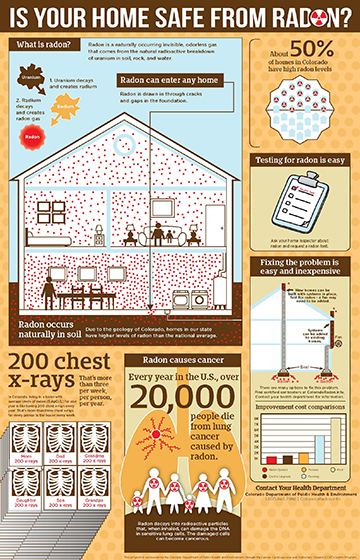Radon Considerations During Real Estate Transactions
Real estate professionals play a critical role in helping customers navigate the home-buying and selling process. An important part of the process is ensuring that buyers are fully aware of any hazards in the home, including radon. By learning the basics of radon, real estate professionals can avoid potential delays and liability problems.
Encourage Early Disclosure
The Environmental Conditions portion of the Colorado Seller’s Property Disclosure Form specifically lists radon as a hazard that must be disclosed if the seller knows it exists or has ever existed. This is true even if previous test results were less than 4.0 pCi/L.
- Sellers should provide copies of any test results.
- The existence of a radon mitigation system must be disclosed. (It is presumed that radon existed previously and that if the system were to fail, the radon level would return to its original level.)
Encourage Testing of ALL Homes
The source of radon entering a building is generally just beneath it. Soil can vary significantly from one building to another, even within the same neighborhood. Therefore, the decision to test should not be based on test results from adjacent homes, zone maps, or survey maps. Instead, it’s best to encourage every buyer to test for radon.
Encourage Testing at the Time of Sale
Testing at the time of sale should be included as a regular part of the inspection process to:
- Reduce liabilities and buyer anxieties
- Reduce variables and interferences
- Provide information upon which the buyer can make an informed decision
Radon concentrations vary with the season and occupant behavior; however, radon tests conducted at the time of sale identify the potential for elevated radon levels, regardless of the occupants’ living patterns. Radon professionals are trained to identify radon potential, allowing buyers to be reasonably confident that, if the radon potential is low, the levels will also be low when the home is typically occupied and on a long-term basis. This type of testing (short-term) usually takes 2-7 days.
Use a Qualified Radon Professional
Although the homeowner can perform radon testing, the test may be suspect if not conducted by an objective third party, such as a radon measurement professional. And, such professionals are trained to identify radon potential, regardless of the season or occupant behavior. Find a certified radon testing professional. Make sure an approved measurement device is used from a qualified laboratory or manufacturer.
Real Estate Radon Testing Options
- The Continuous Radon Monitor (CRM) testing method involves placing a single electronic monitor in the lowest potentially occupiable portion of the home for a minimum of 48 hours. The monitor reports results in hourly increments to identify unusual swings. Decisions are based on the average reading of the hourly reported results. Ensure your measurement professional is using an approved monitor and follows the calibration requirements for their equipment.
- Simultaneous testing method involves placing two passive test devices four inches apart in the lowest potentially occupiable portion of the home for 48 hours. This allows the tester to safeguard against errors.
- The sequential testing method involves two devices placed in the lowest potentially occupiable portion of the home for 48 hours, one after the other. The average of the two test results forms the basis for a decision.
Test Results
There is no safe level of radon exposure. The average national indoor radon level is approximately 1.3 picoCuries per liter (pCi/L) of air. Homeowners should consider fixing their homes to a level of 2.0 to 4.0 pCi/L. Radon mitigation can be an inexpensive and straightforward process.
Radon Contingencies
When contingencies are written on radon, cite an acceptable level, such as the EPA’s action level of 4.0 pCi/L, and, even before the testing is conducted, discuss whether mitigation is an acceptable method for removing the contingency. See sample contingency language below.
Contingent upon radon test being less than 4.0 pCi/L when conducted by a certified radon measurement professional. If radon is elevated, mitigation repairs may be made, provided they are performed by a licensed and certified radon contractor with an approach acceptable to the buyer, with results less than 4.0 pCi/L as verified by a certified measurement professional.




